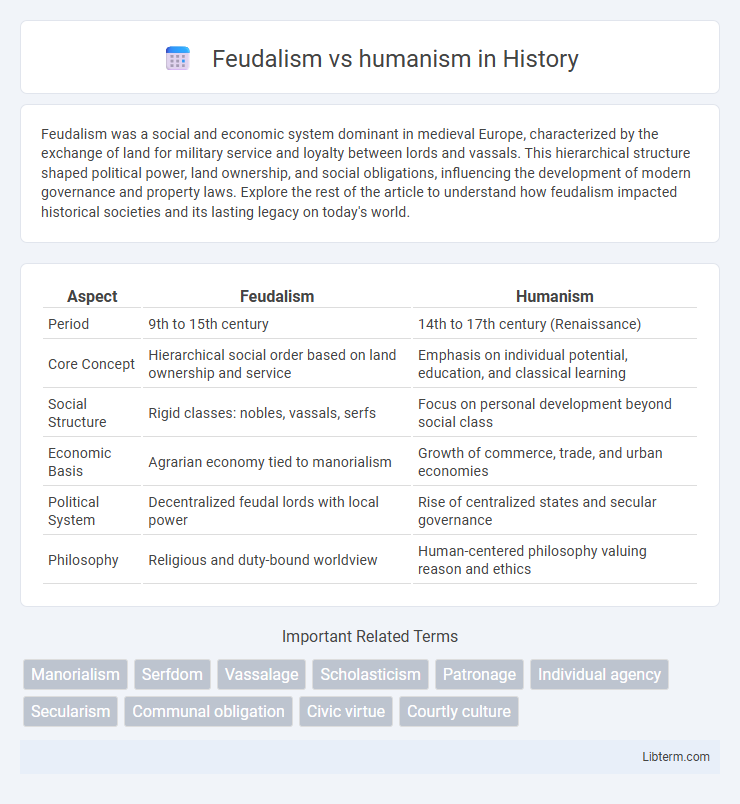Feudalism was a social and economic system dominant in medieval Europe, characterized by the exchange of land for military service and loyalty between lords and vassals. This hierarchical structure shaped political power, land ownership, and social obligations, influencing the development of modern governance and property laws. Explore the rest of the article to understand how feudalism impacted historical societies and its lasting legacy on today's world.
Table of Comparison
| Aspect | Feudalism | Humanism |
|---|---|---|
| Period | 9th to 15th century | 14th to 17th century (Renaissance) |
| Core Concept | Hierarchical social order based on land ownership and service | Emphasis on individual potential, education, and classical learning |
| Social Structure | Rigid classes: nobles, vassals, serfs | Focus on personal development beyond social class |
| Economic Basis | Agrarian economy tied to manorialism | Growth of commerce, trade, and urban economies |
| Political System | Decentralized feudal lords with local power | Rise of centralized states and secular governance |
| Philosophy | Religious and duty-bound worldview | Human-centered philosophy valuing reason and ethics |
Defining Feudalism: Structure and Society
Feudalism is a socio-political system characterized by a rigid hierarchical structure where land ownership and duties are exchanged between lords, vassals, and serfs. The society under feudalism was decentralized, with local lords wielding significant power over agricultural production, justice, and military support. This system emphasized duty, loyalty, and the mutual obligations within a stratified social order, contrasting sharply with the humanist focus on individual potential and rationality.
Humanism Explained: Core Principles
Humanism centers on the intrinsic value and dignity of the individual, emphasizing reason, critical thinking, and empirical evidence as means to understand the world. Unlike feudalism's rigid social hierarchy and focus on duty to lords and monarchs, humanism promotes individual autonomy, education, and the pursuit of knowledge for personal and societal growth. Renaissance humanism revived classical learning and encouraged a more secular approach to life, inspiring developments in art, science, and philosophy by prioritizing human potential over inherited status.
Historical Origins of Feudalism and Humanism
Feudalism originated in medieval Europe around the 9th century as a decentralized political system where land was exchanged for military service and loyalty, rooted in the collapse of the Carolingian Empire and the Viking invasions. Humanism emerged during the Renaissance in the 14th century, driven by the rediscovery of classical Greek and Roman texts, emphasizing individual potential, secularism, and critical thinking. The historical origins of feudalism reflect a socio-political response to instability, while humanism arose from intellectual revival and a shift toward human-centered philosophy.
Social Hierarchies: Feudal Loyalty vs Individual Worth
Feudalism structured society through rigid social hierarchies based on land ownership and reciprocal loyalty between lords and vassals, emphasizing duty and collective responsibility over personal identity. Humanism championed individual worth, stressing personal dignity, intellectual freedom, and the intrinsic value of each human being beyond inherited status. This shift undermined feudal loyalty by promoting self-expression and meritocratic ideals over inherited social ranks.
Power Dynamics: Lords, Serfs, and Human Autonomy
Feudalism structured power dynamics through rigid hierarchies where lords held extensive control over serfs, who were bound to land and labor with limited personal freedom. In contrast, humanism emphasized individual autonomy, personal dignity, and the capacity for self-determination, challenging the oppressive social orders of feudal societies. This shift fostered a new valuation of human agency and critical inquiry that undermined the coercive authority inherent in feudal lordship.
Education and Knowledge: Clergy Control vs Humanist Learning
Feudalism centralized education under the control of the clergy, where knowledge was primarily religious and limited to monasteries and cathedral schools, restricting access to a select elite. Humanism promoted secular learning, emphasizing classical texts and critical thinking, encouraging broader intellectual exploration beyond ecclesiastical boundaries. This shift fostered the development of universities and the dissemination of Renaissance humanist ideals, significantly transforming educational paradigms.
Religion’s Role: Divine Right vs Human Potential
Feudalism emphasized religion's role through the doctrine of divine right, legitimizing monarchs and nobles as God's appointed rulers, which maintained rigid social hierarchies and justified unquestioned authority. Humanism shifted focus to human potential and individual dignity, advocating for education and critical thinking inspired by classical texts rather than spiritual dogma. This transition diminished the church's political dominance, promoting secular governance and human-centered ethics.
Economic Systems: Agrarian Feudalism vs Humanist Progress
Feudalism centered on an agrarian economy structured around land ownership, where serfs worked the lord's estate in exchange for protection, creating a rigid, hierarchical system. Humanism promoted economic progress through increased trade, innovation, and the growth of urban centers, emphasizing individual potential and the value of commerce. The shift from feudal agrarian economies to humanist-driven market economies laid the foundation for modern economic development and capitalist principles.
Art and Culture: Medieval Themes vs Humanist Renaissance
Feudalism's art and culture centered on religious themes, emphasizing medieval iconography, illuminated manuscripts, and Gothic architecture that reinforced societal hierarchy and piety. Humanist Renaissance art shifted focus to classical antiquity, human experience, and naturalism, as demonstrated in the works of Leonardo da Vinci, Michelangelo, and Raphael, highlighting individuality and secular themes. This transition marked a move from collective medieval spirituality to individual expression and empirical observation in art and literature.
Enduring Legacy: Feudalism and Humanism in Modern Thought
Feudalism's hierarchical structure laid foundational concepts of social order and governance influencing modern political systems, while Humanism's emphasis on individual potential and secularism reshaped educational and cultural values in contemporary society. The enduring legacy of Feudalism is evident in institutional frameworks and legal traditions, whereas Humanism's impact thrives in modern human rights discourse and scientific inquiry. Both ideologies continue to inform debates on authority, ethics, and the role of individuals within communities.
Feudalism Infographic

 libterm.com
libterm.com